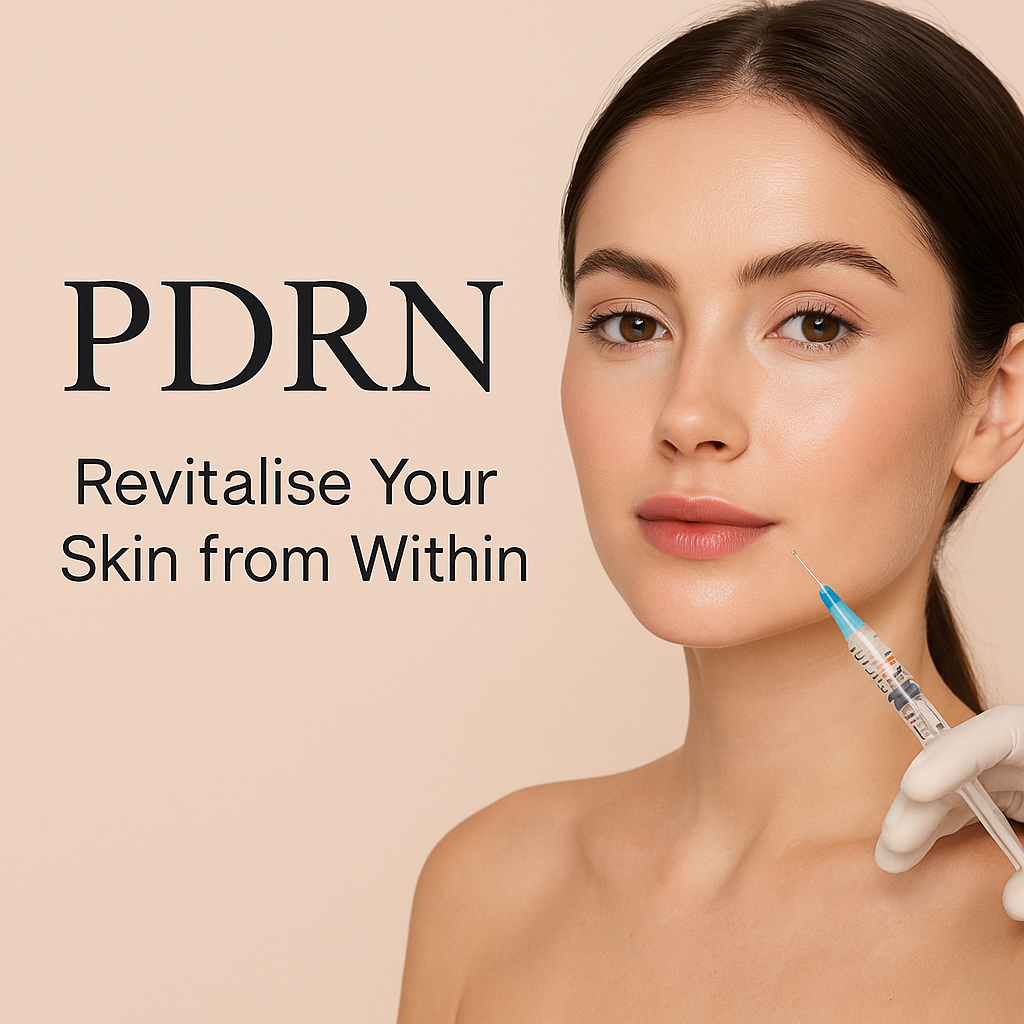
In the ever-evolving world of aesthetics, PDRN (Polydeoxyribonucleotide) is gaining recognition for its powerful regenerative and anti-ageing properties. Derived from salmon or trout DNA, PDRN offers a scientifically backed solution to promote skin healing, rejuvenation, and collagen production, making it a game-changer in aesthetic medicine.
What is PDRN and How Does it Work?
PDRN is a biological molecule composed of DNA fragments that stimulate cell regeneration and tissue repair. When introduced into the skin, it activates fibroblast proliferation, boosts collagen synthesis, and improves microcirculation, resulting in:
- Smoother, firmer and more youthful-looking skin
- Enhanced hydration and improved skin elasticity
- Faster recovery after aesthetic procedures
- Reduction in fine lines, wrinkles and pigmentation
- Improved scar healing and overall skin texture
PDRN vs. Polynucleotides (PN) – What’s the Difference?
While PDRN and polynucleotides (PN) are often used interchangeably, they are not identical. Here’s how they differ:
| Feature | PDRN (Polydeoxyribonucleotide) | Polynucleotides (PN) |
|---|---|---|
| Definition | A specific type of polynucleotide derived from salmon or trout DNA | A broader term encompassing long-chain DNA or RNA molecules |
| Structure | Contains short DNA fragments (50 to 2000 base pairs) | Includes both long and short DNA or RNA chains |
| Primary Action | Regenerative and healing, boosts fibroblast activity, stimulates collagen and promotes wound repair | Anti-inflammatory and skin renewal, stimulates tissue regeneration and reduces oxidative stress |
| Skin Benefits | Improves elasticity, hydration and skin density | Enhances skin tone, reduces inflammation and promotes cellular renewal |
| Treatment Use | Commonly used in injectable biorevitalisation and post-procedure recovery | Used in skin boosters, hair restoration and anti-ageing treatments |
| Longevity | Results last 3 to 6 months with a course of treatments | Results last 4 to 6 months with regular maintenance |
Key Takeaway: PDRN is a specific type of PN with targeted skin regeneration and wound-healing properties. PN is a broader category that encompasses various DNA and RNA chains with wider therapeutic applications.
Aesthetic Applications of PDRN
Biorevitalisation Treatments: Injectable skin boosters that restore moisture, firmness and elasticity
- Post-Procedure Recovery: Speeds up healing after microneedling, chemical peels or facials
- Scar and Stretch Mark Repair: Reduces the appearance of atrophic scars and improves skin texture
- Hair Restoration: Stimulates hair follicle regeneration and promotes thicker, healthier hair
- Anti-Ageing & Brightening: Improves dullness, pigmentation and fine lines
Combining PDRN with Other Aesthetic Treatments
PDRN can be safely combined with other procedures in the same session to enhance results:
- Microneedling + PDRN: Improves penetration, accelerates healing and boosts collagen production
- Facials + PDRN: Enhances facial treatments by boosting skin regeneration, hydration and texture
- Chemical Peels + PDRN: Minimises downtime, soothes irritation and stimulates deep skin regeneration
- HA Skin Boosters + PDRN: Provides both intense hydration and cell renewal for maximum skin improvement
Combining treatments can amplify results, reduce recovery time and provide longer-lasting skin rejuvenation.
FAQ: PDRN in Aesthetics
- 1. What is PDRN made from?
PDRN is derived from salmon or trout DNA, which shares a remarkable similarity to human DNA, making it biocompatible and safe for skin regeneration. - 2. How is PDRN used in treatments?
PDRN is injected through mesotherapy, skin boosters or microneedling procedures. It can also be applied topically post-treatment to enhance skin repair. - 3. Is PDRN safe?
Yes. PDRN is clinically tested and widely used in aesthetic medicine. It has anti-inflammatory properties and promotes healing, making it safe for most skin types. - 4. How long do the results last?
Results vary, but visible improvements in skin texture and hydration are noticeable within 2 to 4 weeks. For optimal results, a course of 3 to 4 treatments is typically recommended, with results lasting several months. - 5. Can PDRN treat pigmentation?
Yes. PDRN stimulates cell turnover and repair, which can reduce post-inflammatory pigmentation and improve skin clarity over time. - 6. Is there downtime after a PDRN treatment?
Minimal downtime. You may experience slight redness or swelling, which typically subsides within 24 to 48 hours. - 7. Can I combine PDRN with other treatments?
Absolutely! PDRN works synergistically with microneedling, facials, chemical peels and HA skin boosters, helping to maximise skin regeneration and speed up recovery.
Experience the Rejuvenating Power of PDRN
If you’re seeking advanced skin regeneration and repair, PDRN treatments offer a clinically proven solution for smoother, healthier and more youthful skin.
Contact us today to learn more about PDRN treatments and how they can transform your skin!
